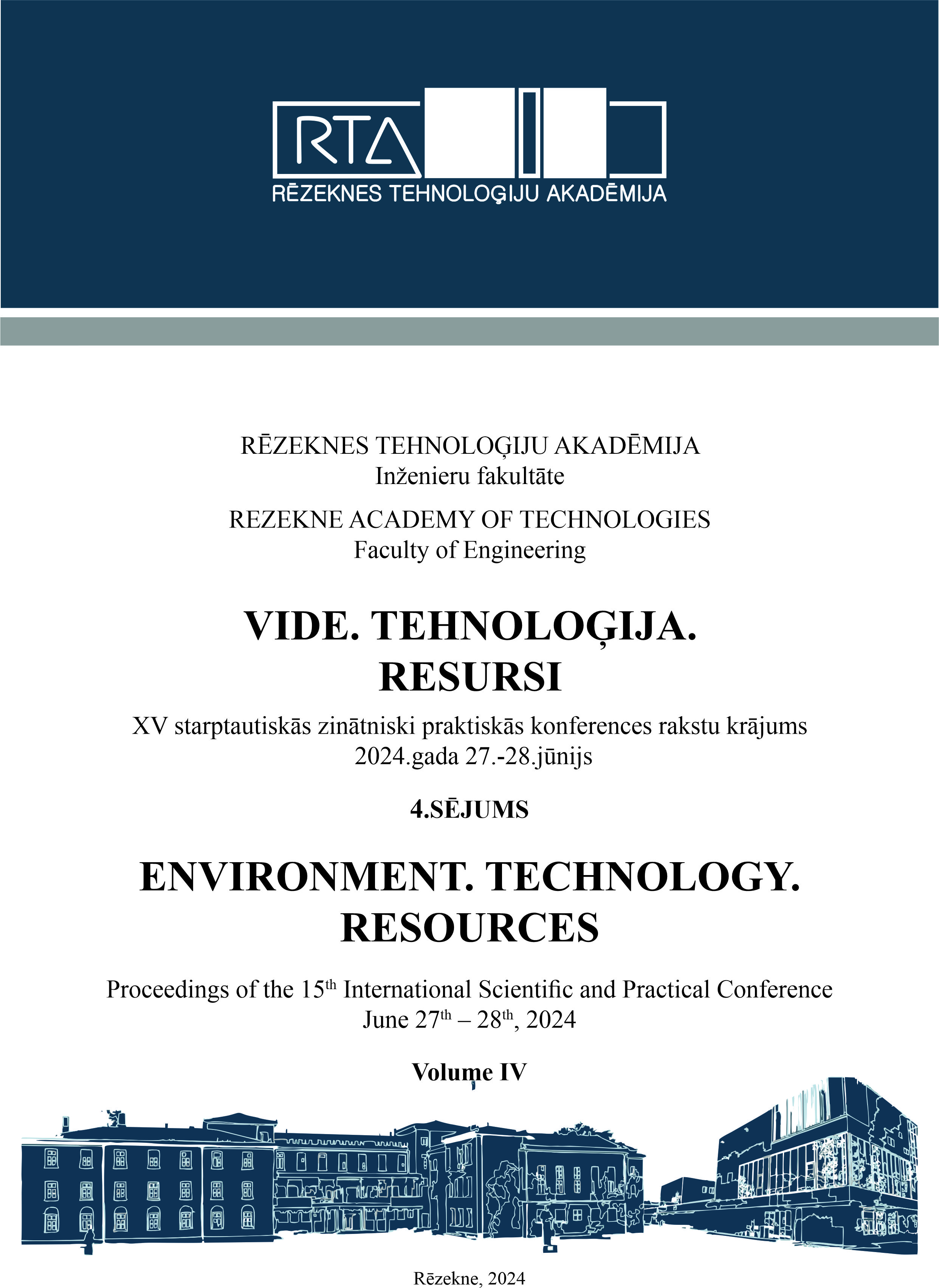EFFECT OF PRECIPITATION AND CONTAMINATION ORIGIN ON THE EFFICIENCY OF PINACOLYL ALCOHOL IDENTIFICATION IN CONCRETE DEBRIS
DOI:
https://doi.org/10.17770/etr2024vol4.8190Keywords:
Chemical weapons, field analysis, gas chromatography, nerve agents, soman, wipe samplingAbstract
Chemical warfare agents (CWAs) pose a significant threat to people and the environment. Nowadays, the war fights take place mostly in urban areas. Here, chemical weapons contaminate materials of different properties, and the behavior of the parent contaminant may vary. Concrete has an alkaline pH and rapidly decomposes chemical warfare agents. The study deals with the analysis of potentially contaminated concrete samples taken from the site of the alleged use of nerve CWA soman (GD, pinacolyl methylphosphonofluoridate) using gas chromatography. The final degradation product of soman alkaline hydrolysis – pinacolyl alcohol (3,3-dimethylbutan-2-ol) – was chosen as the analyte. The method for the preparation of the concrete samples included organic solvent extraction of the contaminant, in which two organic solvents with different polarity, namely acetone and ethyl acetate, were used separately for comparison. The applicability of the method; the extraction efficiency from concrete debris at given time intervals from the time of contamination to the start of extraction; the effect of moisture addition before and after contamination; and the effect of the extractant used were studied. The possibilities of wipe sampling of the concrete surface in case of point and area contamination with pinacolyl alcohol were also monitored. The precision of the quantitative analysis was expressed by measuring the standard deviation and was worse in the case of ethyl acetate. The highest recovery values were observed with extraction from dry concrete, followed by concrete moistened after contamination. In the case of area contamination, a lower efficiency of surface wipe sampling was found. The results are particularly useful in the field analysis of samples after the use of chemical weapons.References
A. Vautravers, “Military operations in urban areas,” International Review of the Red Cross, vol. 92, no. 878, pp. 437–452, Jun. 2010, doi: https://doi.org/10.1017/s1816383110000366.
J. T. Kelly, A. Qualley, G. T. Hughes, M. H. Rubenstein, T. A. Malloy, and T. Piatkowski, “Improving Quantification of tabun, sarin, soman, cyclosarin, and sulfur mustard by focusing agents: A field portable gas chromatography-mass spectrometry study,” Journal of Chromatography A, vol. 1636, p. 461784, Jan. 2021, doi: https://doi.org/10.1016/j.chroma.2020.461784.
“Schedule 1,” OPCW. https://www.opcw.org/chemical-weapons-convention/annexes/annex-chemicals/schedule-1
D. Hank Ellison, Handbook of Chemical and Biological Warfare Agents, Volume 1. 2022. doi: https://doi.org/10.4324/9781003230571.
I. S. Che Sulaiman et al., “A review on analysis methods for nerve agent hydrolysis products,” Forensic Toxicology, vol. 38, no. 2, pp. 297–313, Dec. 2019, doi: https://doi.org/10.1007/s11419-019-00513-x.
S. Popiel and M. Sankowska, “Determination of chemical warfare agents and related compounds in environmental samples by solid-phase microextraction with gas chromatography,” Journal of Chromatography A, vol. 1218, no. 47, pp. 8457–8479, Nov. 2011, doi: https://doi.org/10.1016/j.chroma.2011.09.066.
T. Rozsypal, Kristyna Zitova, and Ludmila Mravcova, “Overcoming the BSTFA: Study on Trimethylsilylation Derivatization Procedures for Chemical Weapons Convention-Related Alcohols in Field Analysis,” Analytical Letters, pp. 1–17, Nov. 2023, doi: https://doi.org/10.1080/00032719.2023.2281587.
J. W. Williams et al., “Degradation Kinetics of VX on Concrete by Secondary Ion Mass Spectrometry,” Langmuir, vol. 21, no. 6, pp. 2386–2390, Feb. 2005, doi: https://doi.org/10.1021/la047933j.
Y. Sumra, S. Payam, and I. Zainah, “The pH of Cement-based Materials: A Review,” Journal of Wuhan University of Technology-Mater. Sci. Ed., vol. 35, no. 5, pp. 908–924, Oct. 2020, doi: https://doi.org/10.1007/s11595-020-2337-y.
A. M. Neville, Properties of concrete. Harlow Pearson Education, 2012.
C. A. S. Brevett, K. B. Sumpter, G. W. Wagner, and J. S. Rice, “Degradation of the blister agent sulfur mustard, bis(2-chloroethyl) sulfide, on concrete,” Journal of Hazardous Materials, vol. 140, no. 1–2, pp. 353–360, Feb. 2007, doi: https://doi.org/10.1016/j.jhazmat.2006.09.067.
H. Jung and S. Choi, “Behavior of sulfur mustard in sand, concrete, and asphalt matrices: Evaporation, degradation, and decontamination,” Journal of Environmental Science And Health, Part A, vol. 52, no. 12, pp. 1121–1125, Jul. 2017, doi: https://doi.org/10.1080/10934529.2017.1342498.
C. J. O’Brien, J. A. Greathouse, and C. M. Tenney, “Dissociation of Sarin on a Cement Analogue Surface: Effects of Humidity and Confined Geometry,” The Journal of Physical Chemistry C, vol. 120, no. 49, pp. 28100–28109, Dec. 2016, doi: https://doi.org/10.1021/acs.jpcc.6b10046.
H. Jung, J. Lee, H. Park, and J. A. Seo, “Fate of Nerve Agent Tabun in Concrete and Soil: Evaporation and Decontamination,” Environmental Engineering Science, vol. 36, no. 6, pp. 650–655, Jun. 2019, doi: https://doi.org/10.1089/ees.2018.0535.
T. Rozsypal, “Use of aliphatic thiols for on-site derivatization and gas chromatographic identification of Adamsite,” Journal of The Serbian Chemical Society, vol. 88, no. 6, pp. 639–652, Jan. 2023, doi: https://doi.org/10.2298/jsc221207025r.
“Blue Book | VERIFIN | University of Helsinki,” www.helsinki.fi. https://www.helsinki.fi/en/verifin/about-verifin/blue-book
M. L. Kuitunen and N. Hamzah, "Concrete samples" in P. Vanninen (ed.) "Recommended operating procedures for analysis in the verification of chemical disarmament, 2023 Edition", University of Helsinki, Finland, 2023, pp. 335–342. http://www.helsinki.fi/verifin/bluebook
Precast concrete products – Normal weight and lightweight concrete shuttering, EN 15435, 2008.
Concrete – Specification, performance, production and conformity, EN 206+A2, 2013
T. Błaszczyński and M. Przybylska-Fałek, “Steel Fibre Reinforced Concrete as a Structural Material,” Procedia Engineering, vol. 122, pp. 282–289, 2015, doi: https://doi.org/10.1016/j.proeng.2015.10.037.
Downloads
Published
Issue
Section
License
Copyright (c) 2024 Jakub Pavlik, Tomas Rozsypal

This work is licensed under a Creative Commons Attribution 4.0 International License.



